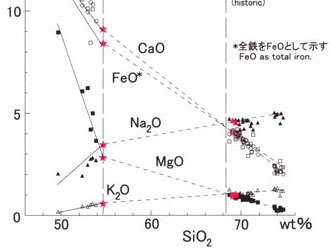Usu Volcano - 2nd Edition -
Introduction to the 1st edition (1981) / 1 : Geology of Usu Volcano and environments / 2 : Outline of Usu Volcano
3 : Eruptions of historical times
Characteristics of the eruptions of historical times
4 : Rocks of Usu Volcano
5 : Surveillance and observation of activities / 6 : Prediction of future activities and mitigation of damage
References / Note
![]() PREV
PREV ![]() NEXT
NEXT
4: Rocks of Usu Volcano
The somma lava, which is the major constituent of Usu Volcano, is basalt to basaltic andesite, but the ones forming lava domes erupted during historical times since 1663 are rhyolite to dacite.
The basalt and basaltic andesite are dark grey to dark brownish gray in color and in general characteristically porphyritic with phenocrysts of plagioclase, olivine, orthopyroxene ( hypersthene ), and clinopyroxene ( augite ), and occasionally contain large phenocrysts of anorthite with diameter of 2-3 cm. The groundmass shows intersertal to intergranular texture and consists largely of plagioclase and clinopyroxene ( augite, pigeonite ) with little titanomagnetite, cristobalite, apatite, and volcanic glass.
Rhyolite occurs as pumice fall of 1663 ( Us-b Bed ) mostly in well vesiculated white volcanic glass containing little plagioclase, orthopyroxene ( ferrosilite ), and titanomagnetite phenocrysts. In rhyolitic pumice, rare clinopyroxene ( augite ) and hornblende are contained in addition to the above, but no quartz.
Dacite occurs as lava domes, pumice, bread crust bomb, and volcanic blocks. Rocks of lava domes are invariably compact and pale grey colored with phenocrysts of little plagioclase and orthopyroxene ( hypersthene ). The groundmass shows intersertal to intergranular texture and consists of plagioclase, cristobalite, anorthoclase, orthopyroxene ( hypersthene ), titanomagnetite, apatite, and volcanic glass. In addition to those, quartz, clinopyroxene (augite), and hornblende occur rarely. Volcanic blocks and bread crust bomb in general show glassy groundmass, while pumice is mostly colorless to grayish white vesiculated glass, and like lava dome, contains a little plagioclase, orthopyroxene ( hypersthene ) and titanomagnetite phenocrysts.
Representative chemical compositions of rocks from Usu Volcano are shown in ![]() Table 2. Somma lava is low in SiO2 in 49 to 53 % and rich in Al2O3, FeO+Fe2O3, CaO, and MgO. On the other hand, pumice and lava dome of historical times are rich in SiO2 at 68 to 73 %, and in general poor in Al2O3, FeO+Fe2O3, CaO, and MgO (
Table 2. Somma lava is low in SiO2 in 49 to 53 % and rich in Al2O3, FeO+Fe2O3, CaO, and MgO. On the other hand, pumice and lava dome of historical times are rich in SiO2 at 68 to 73 %, and in general poor in Al2O3, FeO+Fe2O3, CaO, and MgO ( ![]() Fig. 8 ). Common characteristic features of those rocks are poor in alkalis especially in K2O. In Usu Volcano, rocks of intermediate SiO2 compositions ( 55 to 66 % ) do not occur. During several thousand years of dormant phase between the formation of the somma and the activity of historical times, this very silicic magma must have evolved.
Fig. 8 ). Common characteristic features of those rocks are poor in alkalis especially in K2O. In Usu Volcano, rocks of intermediate SiO2 compositions ( 55 to 66 % ) do not occur. During several thousand years of dormant phase between the formation of the somma and the activity of historical times, this very silicic magma must have evolved.
Ejecta during historical times are silicic as above. Especially the earliest materials are rhyolite with highest SiO2 while slightly decreasing in SiO2 and slightly increasing in Al2O3, FeO+Fe2O3, MgO, and CaO to become dacitic with time. This change in composition suggests that the magma reservoir has a chemical gradient with rhyolitic magma at the top and dacitic at the bottom. In the historical eruptions, it is interpreted that the materials were ejected starting from the top and ejection gradually reached to the lower layer.
Experimental petrology ( experimental work using high-temperature and high-pressure apparatus to investigate igneous or metamorphic conditions ) indicates that there are two magma chambers under the volcano ( about 10 km and 4 - 6 km deep ), and the upper one has the chemical gradient.
 ZOOM
ZOOM 